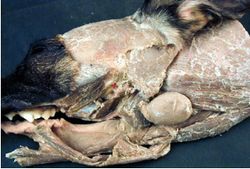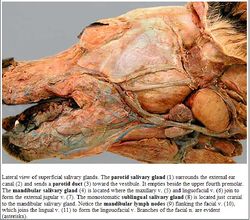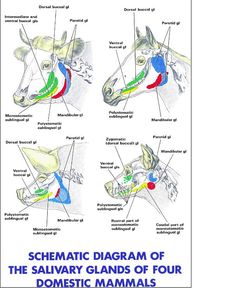Difference between revisions of "Salivary Glands Overview - Anatomy & Physiology"
| Line 45: | Line 45: | ||
==Links== | ==Links== | ||
| − | |||
| − | |||
'''Click here for information on [[:Category:Salivary Glands - Pathology|Salivary Glands Pathology]]''' | '''Click here for information on [[:Category:Salivary Glands - Pathology|Salivary Glands Pathology]]''' | ||
| + | {{Template:Learning | ||
| + | |flashcards= [[Oral Cavity - Anatomy & Physiology - Flashcards#Salivary Glands Flashcards|Salivary Glands]] | ||
| + | |powerpoints= [[Oral Cavity Histology resource|Oral Cavity Histology, see part 2 for salivary glands]] | ||
| + | }} | ||
[[Category:Salivary Glands - Anatomy & Physiology]] | [[Category:Salivary Glands - Anatomy & Physiology]] | ||
[[Category:A&P Done]] | [[Category:A&P Done]] | ||
Revision as of 16:59, 10 June 2011
Introduction
The oral cavity is drained by numerous salivary glands. The saliva secreted keeps the mouth moist and facilitates mastication by lubricating the passage of the bolus.
Salivary glands are present in the cheek, tongue, lips, oesophagus, soft palate and pharynx but the major salivary glands are located further away from the oral cavity and function through connective ducts.
Saliva provides digestive enzymes, is a route of excretion of substances which accumulate on the teeth and provides lubricative and also cleansing functions. Salivary glands can produce a serous secretion, a mucous secretion or both.
Types of Salivary Glands
Major Salivary Glands
Parotid (glandula parotis), Mandibular (glandula mandibularis), Sublingual (glandula sublinguales) and Zygomatic (glandula zygomatica).
Minor Salivary Glands
Labial, Lingual, Buccal and Palatine.
Innervation
The salivary glands are innervated by sympathetic- Vasoconstriction occurs and the flow of saliva is decreased.
The salivary glands are also innervated by parasympathetic (most important)- They travel from the brainstem by the facial (CN VII) and glossopharyngeal (CN XI) then into branches of the trigeminal nerve (CN V). The flow of salivary fluid increases and vasodilation occurs.
The main nerves are the occulomotor (CN III), facial (CN VII), glossopharyngeal (CN IX) and vagus (CN X).
Saliva
Saliva is mainly water and contains amylase for carbohydrate digestion, salt- mainly sodium bicarbonate, mucin, electrolytes, antimicrobial agents and lingual lipase.
Species Differences
Equine
Produce up to 40L per day.
Bovine
Produce 110-180L per day.
Porcine
Produce up to 15L per day.
Links
Click here for information on Salivary Glands Pathology
| Salivary Glands Overview - Anatomy & Physiology Learning Resources | |
|---|---|
 Test your knowledge using flashcard type questions |
Salivary Glands |
 Selection of relevant PowerPoint tutorials |
Oral Cavity Histology, see part 2 for salivary glands |


